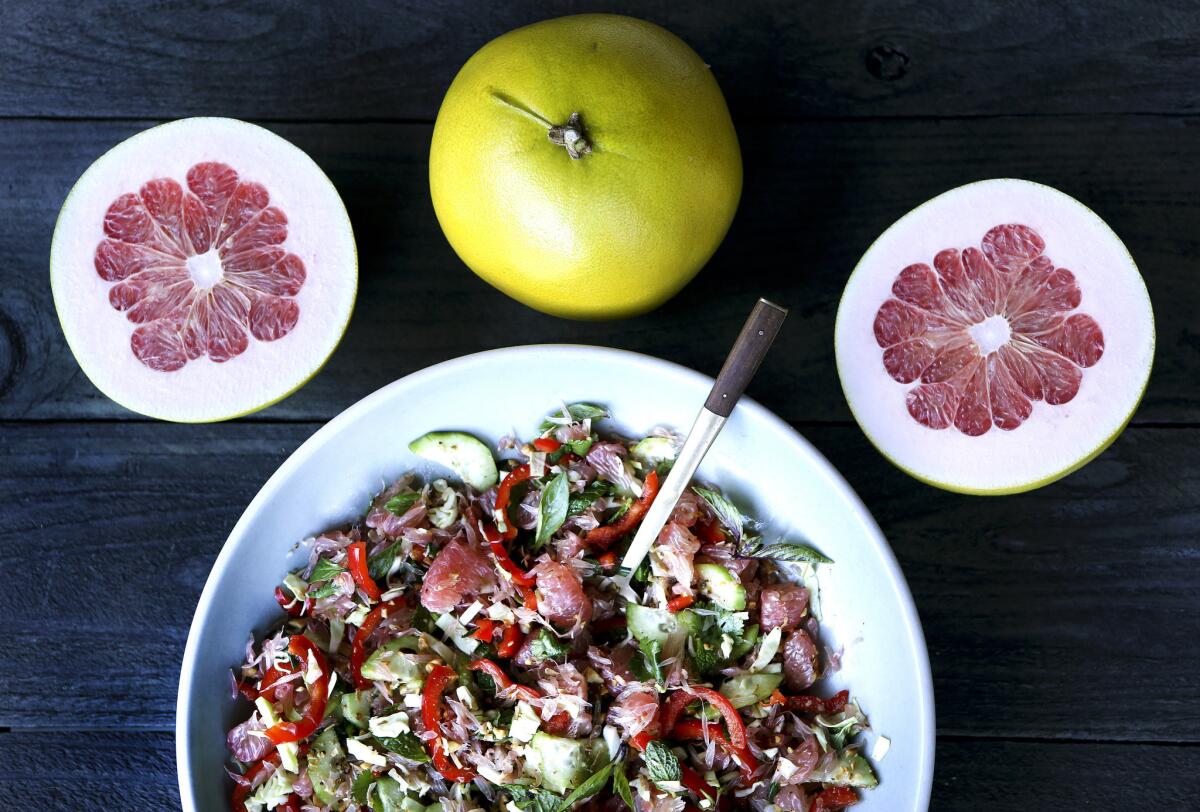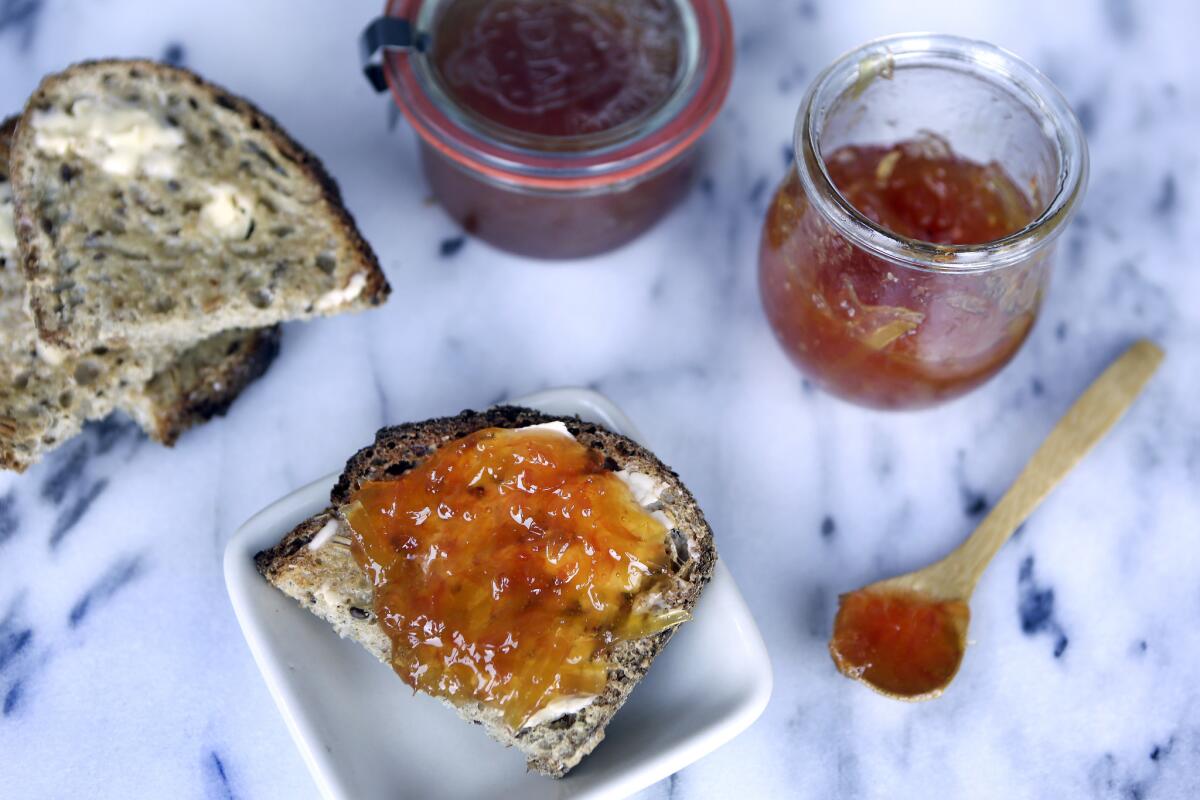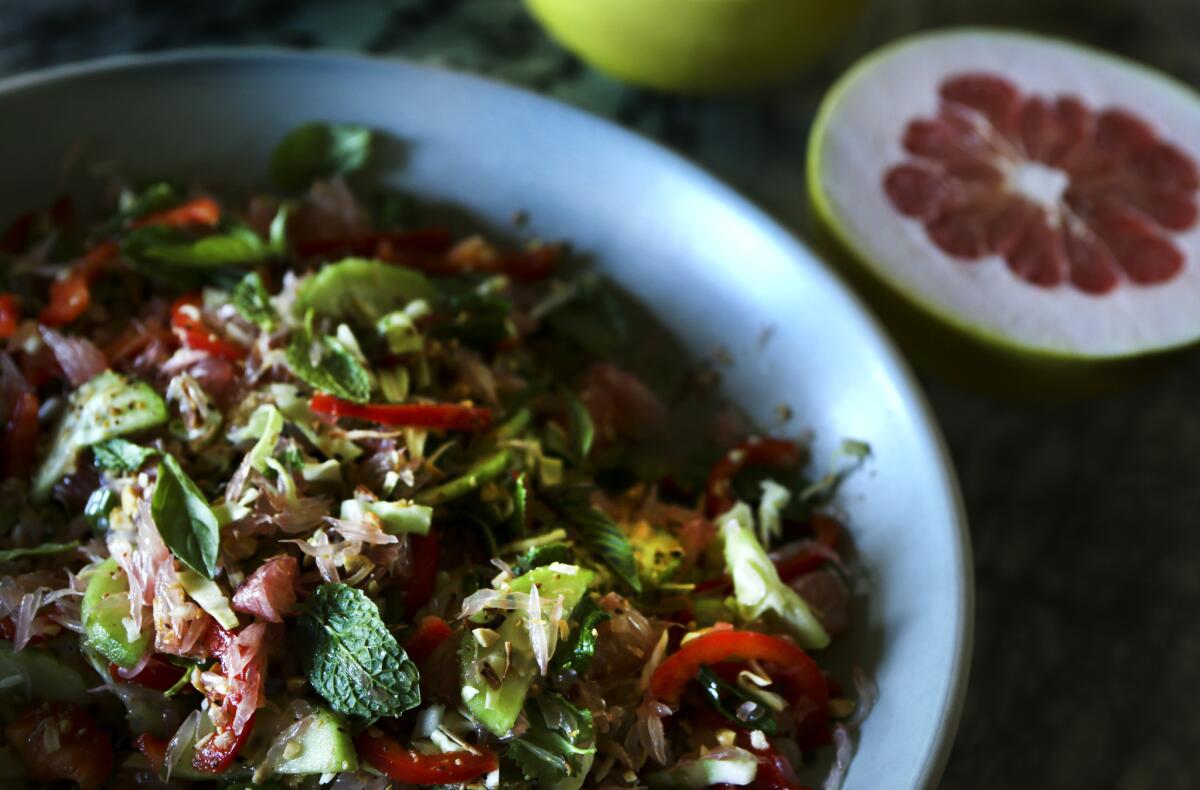Pomelos, grapefruit’s sweeter and mellower relative, have a wealth of flavor

Pomelo salad Phnom Penh (a Cambodian citrus, vegetable and herb salad) photographed at the home of Jeanne Kelley in Los Angeles.
- Share via
In late winter in Southern California, we’re spoiled by citrus. Look around most neighborhoods and you see trees laden with oranges and lemons and limes. At local farmers markets, vendors display more exotic citrus: kumquats, tangerines, Meyer lemons, calamondins and maybe even finger limes. But if you’re lucky, you’ll also find the near-volleyball-sized Citrus maxima. This “biggest citrus” is the pomelo, a sweeter, mellower and more floral relative of the grapefruit, which is, by the way, a cross between a pomelo and an orange. You can find pomelos, which are available from late fall to early spring, in the produce aisles of well-stocked grocery stores, but they’re most fun to get at farmers markets, where they look rather liked balls racked at a bowling alley.
Despite their deliciousness, pomelos didn’t come to the U.S. marketplace easily. The first pomelo trees were acquired from Thailand in 1902 by the Department of Agriculture. After a season in a D.C. greenhouse, only one tree survived. Budwood (short, budded branches) from the lone tree were sent to Florida, California, Puerto Rico, Cuba and Trinidad to be grafted onto healthy rootstock. When fruit from the original tree ripened, it was of such poor quality that the pomelo program was scrapped. Luckily other traveling horticulturists discovered pomelos and subsequent grafts produced the sweet and juicy fruit that grows easily in California today.
See the most-read stories in Life & Style this hour >>
Pomelos come in many varieties. In fact, the UC Riverside Citrus Experiment Station, a university program dedicated to the study of all things citrus, has more than 60 varieties growing in its Citrus Variety Collection. The skin of the pomelo can be yellow, yellow-green or even blush pink, and the shape can range from orb to pear, with sizes starting at softball and graduating to volleyball. The pulp varies from pale yellow to dark grapefruit ruby. Pomelos can be overly juicy or verging on dry. Good pomelos taste sweeter than grapefruit, with almost no bitterness and floral notes; undesirable pomelos are simply too sour. The most readily available pomelo in the marketplace is the Chandler, with chartreuse skin and pale pink flesh. Pomelo hybrids, such as the sweet oro blanco and mild Melogold, are becoming more widely available.

Pomelo with yogurt cream and whole wheat crumbles.
Recipe: Pomelo with yogurt cream and sweet crumbles
The pomelo is like an annoyingly well-wrapped postal package. The rind is a firm and glossy coating over a thick cushion of pith. Beneath the dense peel is a tight orb of segments, each encased in a tough and exceptionally bitter membrane. Once freed, the succulent pulp sacks either remain clustered into arc-shaped citrus supremes or detach into rice.
Here’s the easiest way to ready a pomelo: Using a large, serrated knife, slice off the stem end of the pomelo, cutting into the pith but not the pulp. Using your fingers, peel away all of the pith. Separate the segments and with the aid of kitchen shears or a small sharp knife, cut into the membrane at the center of each segment and peel it away from the pulp. If your pomelos are juicy, work over a bowl to catch the juice.

Pomelo marmalade recipe.
Save the rind and use it to make preserves, where it becomes the IPA of marmalades, with floral and fruity notes and a hoppy-like bitterness. Add some cardamom to the mix, as pomelos pair well with spices, aromatic herbs and particularly fresh ginger — the citrus is terrific made into a compote that you can serve, with tangy yogurt and whole-wheat crumbles in a dessert parfait. And because pomelo trees flourish on the banks of rivers that flow into the South China Sea and the Gulf of Thailand, it’s a natural to toss the pulp with the funk of fish sauce, chile and lime in a craveable mix that’s as refreshing as a green papaya salad.

Pomelo salad Phnom Penh (a Cambodian citrus, vegetable and herb salad).
Recipe: Cambodian pomelo salad
The next time you shop for citrus, you should consider placing a pomelo or two in your market basket. There might not be room for anything else, but mild, fruity and intensely aromatic, there’s a wealth of flavor in these fruits — if you can get over the sheer absurdity of their size.
Jeanne Kelley is a Los Angeles cook and cookbook author who also writes at Jeanne Kelley Kitchen.
More to Read
Eat your way across L.A.
Get our weekly Tasting Notes newsletter for reviews, news and more.
You may occasionally receive promotional content from the Los Angeles Times.










